The Legion Body Fat Percentage Calculator helps you estimate the percentage of your total weight that’s body fat.
Enter your preferred unit of measurement (imperial or metric), gender, weight, and age. Then, choose the body fat formula you’d like to use (explained below). Take the required skinfold caliper or tape measurements, plug in the numbers, and the calculator will estimate your body fat percentage.
This calculator also serves as an “ideal body fat percentage calculator.” It provides insights into how your current body fat percentage impacts your health. It also offers suggestions on increasing or reducing body fat to reach an “ideal” range for optimal well-being.
Body Fat Percentage Reference Points
The American Council on Exercise Body Fat Ranges
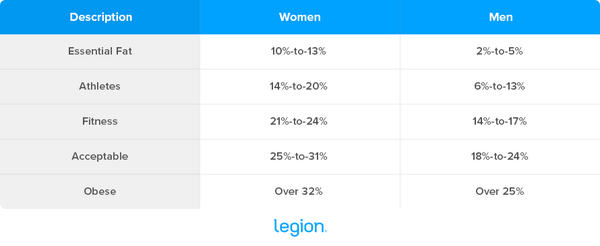
Jackson & Pollock Ideal Body Fat Percentages
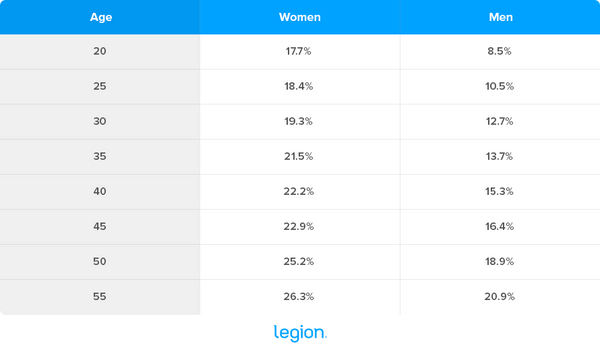
Why Should I Control My Body Fat Percentage?
Your body fat percentage is a key indicator of overall health and wellness.
Unlike body mass index (BMI), which doesn’t differentiate between muscle and fat, body fat percentage offers a clearer view of your body composition and, consequently, your health.
Having too much body fat, particularly subcutaneous fat, increases your risk of various health complications. For instance, carrying excess fat increases your risk for heart diseases like high blood pressure and atherosclerosis.
Additionally, a high body fat percentage contributes to insulin resistance, a major cause of type 2 diabetes. Effectively managing your body fat can help prevent these health issues and guide you toward a healthier life.
Ways to Measure Body Fat
There are numerous ways to measure your body fat percentage. Let’s explore the most popular ones and discuss their accuracy.
Body Composition Scales & Handheld Devices
Body composition scales and handheld devices use bioelectrical impedance analysis (BIA) to measure body fat percentage.
They’re highly inaccurate because BIA passes a light electrical current through your body, which muscle conducts well (due to its high water content), and fat doesn’t. Theoretically, this should correlate electrical resistance with body fat levels, but there are major flaws.
First, electricity prefers the path of least resistance, bypassing fat for more conductive tissues, causing these devices to overlook substantial fat areas.
Second, BIA bases its predictions on equations that often yield imprecise results.
Lastly, factors like hydration, food intake, and recent exercise can significantly skew the readings, rendering BIA inconsistent and unreliable.
Pictures and The Mirror
Estimating a person’s body composition based on visual appearance is challenging due to differences in muscle mass among individuals with similar body fat percentages.
For example, an average 160-pound man with 10% body fat carries 16 pounds of fat. But a muscular 190-pound man with 10% body fat, has just 3 pounds more fat but a remarkable 27 pounds more lean mass, making him appear significantly different from the first man.
Dual-Energy X-Ray Absorptiometry (DXA)
Dual-energy X-ray absorptiometry, or DXA, uses a full-body X-ray to determine total fat and fat-free mass based on the varied X-ray energy absorption of different body tissues. Despite what many believe, DXA isn’t an infallible body fat measuring method.
Machines may yield varying results, even those from the same manufacturer. The algorithms translating raw data into body composition measurements differ, leading to inconsistencies. The kind of X-ray used can also impact the results.
Like BIA, even minor hydration level changes in lean mass can significantly skew DXA results, as can gender, body size, total fat mass, and disease state.
The Bod Pod
The Bod Pod measures the amount of air your body displaces inside a sealed chamber and uses equations to translate this into an analysis of body composition.
However, facial hair, moisture, body temperature, and the tightness of the clothing you wear inside the chamber can affect the Bod Pod’s results, which is why they can be off by 5-to-15%.
Magnetic Resonance Imaging (MRI)
MRI scanners use magnetic fields and radio waves to generate detailed 2D images of the body’s insides. Technicians scrutinize these images to estimate body fat percentage.
The precision of MRI largely depends on the number of images taken. Research shows that estimating body fat based on too few “slices” yields inaccurate results.
Hydrostatic Weighing
Hydrostatic weighing measures body density by comparing your weight on land to your weight underwater. The difference allows for an estimation of body fat percentage, as fat is less dense than water, and lean tissue is denser.
However, this method isn’t foolproof. Factors like ethnicity, body weight, and hydration status can skew results, causing potential inaccuracies of up to 6%.
Body Fat Calipers and Skinfold Testing
Calipers measure the thickness of your skin at specific body points during skinfold testing. These measurements feed into equations that estimate your body’s lean and fat mass. There are a few ways this can go wrong.
Grabbing too little or too much skin and fat will give falsely low or high readings. The equations that convert skin thickness into a body fat percentage can also generate inaccurate results, though this typically only affects individuals with low body fat levels (less than 15% or 25% for men and women, respectively).
Given the practicality and relative cheapness of body fat calipers, using skinfold measurements is one of the primary ways I recommend tracking your body composition.
Here’s how to do it accurately:
1. Pinch your skin by placing the thumb and forefinger on your body about two inches apart (or further if there’s a lot of fat in this area), firmly pushing them into your flesh:

2. Push your fingers together, then gently pull the skinfold away from your body:
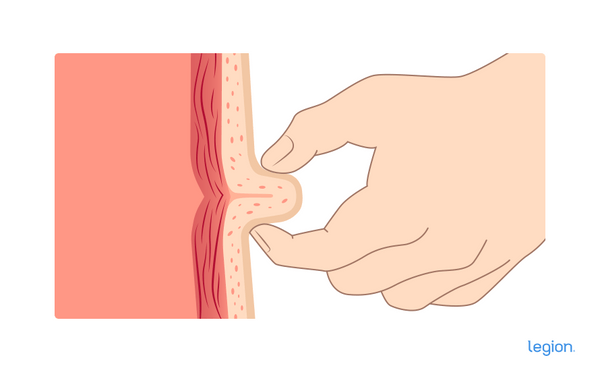
3. Measure a pinched skinfold by placing the tips of the caliper in the middle of the skinfold about an inch from your fingers. For example, the illustration below shows someone taking a suprailiac skinfold measurement:
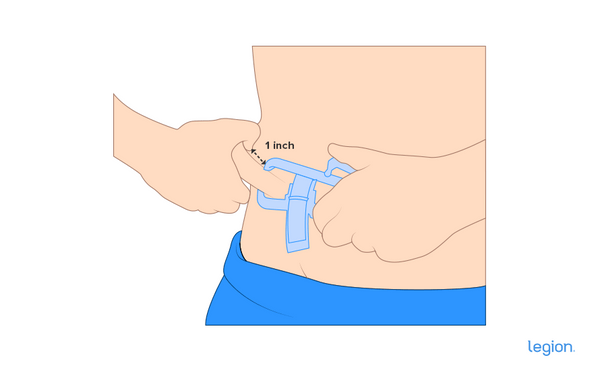
4. Compress the caliper until it clicks (and no more), and note the measurement:
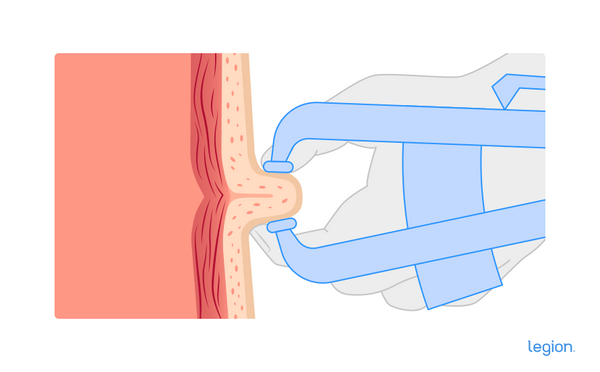
When taking your measurements, bear the following in mind:
- Take all measurements on the right side of your body, standing with your muscles relaxed.
- Ensure your skin is dry and lotion-free.
- Avoid taking measurements after anything physically demanding or when you’re hot, as this can temporarily increase the amount of fluid beneath your skin, inflating your skinfold thickness.
- Take body fat caliper measurements at the same time of day each time.
- If you’re a woman, avoid taking body fat caliper measurements during your menstrual cycle when you gain noticeable weight.
Finally, here are the various skinfold sites and how to measure them:
- Abdominals: Pinch a vertical fold of skin one inch to the right of your belly button.
- Biceps: Pinch the skin vertically halfway between the elbow and shoulder on the front of your arm.
- Calf: Pinch the skin vertically on the inside of the largest part of the right calf.
- Lower back: Pinch the skin horizontally about 6 inches above the waist and 2 inches to the right of the spine.
- Midaxillary: Pinch the skin vertically below the armpit at the same height as the base of your breastbone.
- Pectoral: For men, pinch a diagonal skinfold halfway between the front edge of your armpit and your right nipple. For women, pinch a diagonal skinfold about two-thirds of the way from your right nipple to the front edge of your right armpit (i.e., closer to your armpit than your nipple).
- Subscapular: Pinch the skin diagonally an inch beneath the middle of your shoulder blade (about three inches to the right of your spine and six inches above your waist).
- Suprailiac: Pinch the skin diagonally above the bony protrusion on the front of the right hip (the iliac crest).
- Thigh: Pinch the skin vertically, halfway between the top of the kneecap and the top of the front of your thigh.
- Triceps: Pinch the skin vertically halfway between the elbow and shoulder on the back of your arm.
Measuring Tape
Your waist circumference (measured at the belly button) is a reliable indicator of fatness: if your waist is shrinking over time, you’re losing fat, and if it’s growing, you’re gaining fat.
The Navy tape measure method is another technique you can use with a measuring tape. This method estimates body fat percentage based on neck and waist circumference for men and neck, waist, and hip circumference for women.
This method is simple, fast, and trustworthy. However, it’s not without limitations. It tends to overestimate body fat in lean individuals, specifically in men below 15% body fat and women below 25%.
Here’s how to do the Navy tape measure method:
- For men, measure the circumference of the waist horizontally around the navel. For women, measure at the narrowest point of the waist. The individual should maintain a natural posture without sucking in their stomach.
- Wrap the tape measure around the relaxed neck with the tape angled slightly downward in front.
- For women, measure the hip circumference at its widest point.
Return to the body fat calculator above and change the “Body fat formula” to the “Navy tape measure method. Then, input your measurements.
FAQ #1: How do you calculate body fat percentage?
Aside from skinfold caliper measurements, the most common ways of calculating body fat percentage are bioelectrical impedance analysis (BIA), dual-energy X-ray absorptiometry (DXA), and Bod Pod.
Many people claim that these high-tech methods are more accurate than using skinfold caliper measurements and pictures, but research shows this is false. While some of these methods can produce accurate results for groups (particularly DXA), none of them work well for estimating an individual’s body fat percentage, as they can over- or underestimate your true body fat percentage by 5-to-15% or more.
That is, a BIA device might pin your body fat percentage at 10%, when you could be 25% body fat in reality.
FAQ #2: What does a 20% body fat percentage look like?
The appearance of a 20% body fat percentage can vary significantly depending on how much muscle you have. That said, the following images are a good guideline:
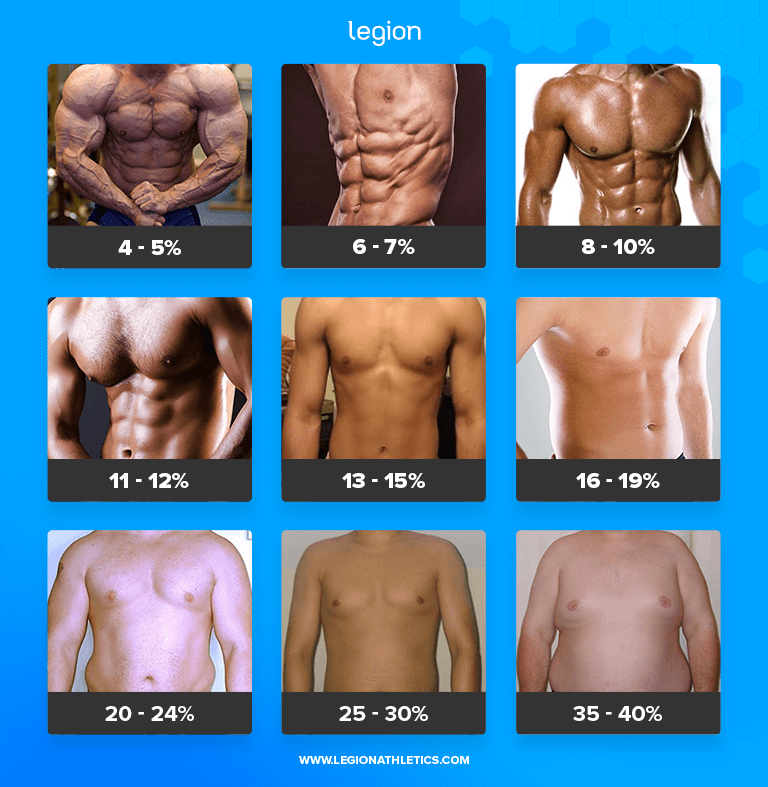
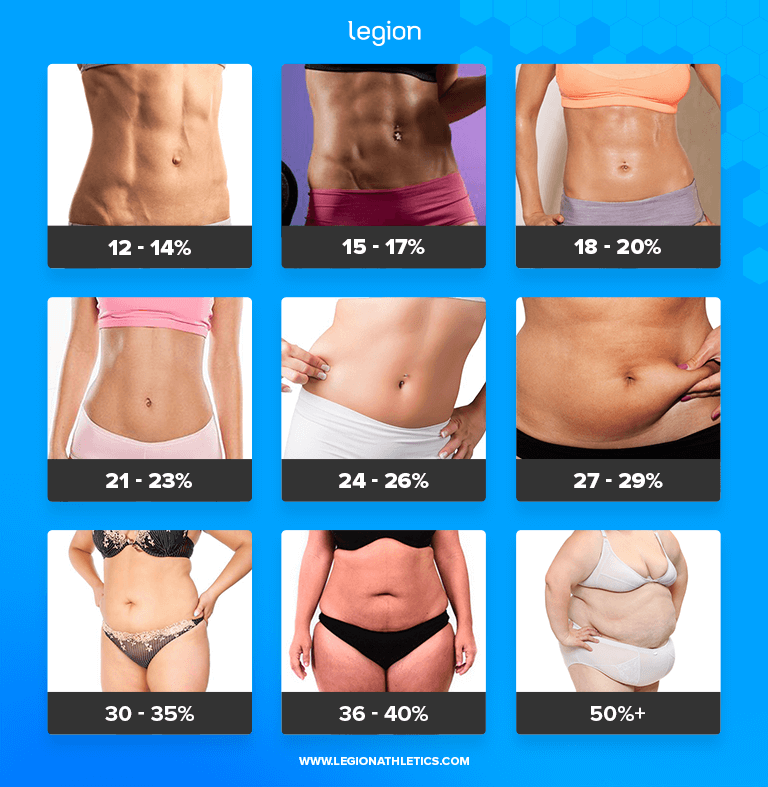
FAQ #3: Which body fat calculator is most accurate?
Provided you accurately measure your body fat using skinfold calipers, then any body fat percentage calculator employing the 3-site Jackson-Pollock formula is likely to provide reasonably accurate results.
+ Scientific References
- Bosy-Westphal, Anja, et al. “Accuracy of Bioelectrical Impedance Consumer Devices for Measurement of Body Composition in Comparison to Whole Body Magnetic Resonance Imaging and Dual X-Ray Absorptiometry.” Obesity Facts, vol. 1, no. 6, 2008, pp. 319–324, https://doi.org/10.1159/000176061. Accessed 30 Sept. 2020.
- Bergsma–Kadijk, Janneke A., et al. “Measurement of Body Fat in Young and Elderly Women: Comparison between a Four-Compartment Model and Widely Used Reference Methods.” British Journal of Nutrition, vol. 75, no. 5, May 1996, pp. 649–657, https://doi.org/10.1079/bjn19960170.
- Lukaski, H. C., et al. “Validation of Tetrapolar Bioelectrical Impedance Method to Assess Human Body Composition.” Journal of Applied Physiology, vol. 60, no. 4, 1 Apr. 1986, pp. 1327–1332, https://doi.org/10.1152/jappl.1986.60.4.1327. Accessed 26 Sept. 2019.
- Slinde, Frode, and Lena Rossander-Hulthén. “Bioelectrical Impedance: Effect of 3 Identical Meals on Diurnal Impedance Variation and Calculation of Body Composition.” The American Journal of Clinical Nutrition, vol. 74, no. 4, 1 Oct. 2001, pp. 474–478, https://doi.org/10.1093/ajcn/74.4.474. Accessed 17 Oct. 2019.
- Abu Khaled, M, et al. “Electrical Impedance in Assessing Human Body Composition: The BIA Method.” The American Journal of Clinical Nutrition, vol. 47, no. 5, 1 May 1988, pp. 789–792, https://doi.org/10.1093/ajcn/47.5.789. Accessed 23 Jan. 2020.
- Ioannidou, E., et al. “Pencil-Beam versus Fan-Beam Dual-Energy X-Ray Absorptiometry Comparisons across Four Systems: Appendicular Lean Soft Tissue.” Acta Diabetologica, vol. 40, no. S1, Oct. 2003, pp. s83–s85, https://doi.org/10.1007/s00592-003-0034-x. Accessed 22 Jan. 2021.
- Williams, Jane E, et al. “Evaluation of Lunar Prodigy Dual-Energy X-Ray Absorptiometry for Assessing Body Composition in Healthy Persons and Patients by Comparison with the Criterion 4-Component Model.” The American Journal of Clinical Nutrition, vol. 83, no. 5, 1 May 2006, pp. 1047–1054, https://doi.org/10.1093/ajcn/83.5.1047.
- Higgins, Paul B., et al. “Effect of Scalp and Facial Hair on Air Displacement Plethysmography Estimates of Percentage of Body Fat.” Obesity, vol. 9, no. 5, May 2001, pp. 326–330, https://doi.org/10.1038/oby.2001.41. Accessed 13 Aug. 2021.
- Fields, David A, et al. “Assessment of Body Composition by Air-Displacement Plethysmography: Influence of Body Temperature and Moisture.” Dynamic Medicine, vol. 3, no. 1, 2004, p. 3, dx.doi.org/10.1186%2F1476-5918-3-3, https://doi.org/10.1186/1476-5918-3-3.
- Fields, DA, et al. “Validation of the BOD POD with Hydrostatic Weighing: Influence of Body Clothingin.” International Journal of Obesity, vol. 24, no. 2, Feb. 2000, pp. 200–205, https://doi.org/10.1038/sj.ijo.0801113. Accessed 18 Mar. 2021.
- COLLINS, MITCHELL A., et al. “Effect of Race and Musculoskeletal Development on the Accuracy of Air Plethysmography.” Medicine & Science in Sports & Exercise, vol. 36, no. 6, June 2004, pp. 1070–1077, https://doi.org/10.1249/01.mss.0000128182.76254.05. Accessed 16 Nov. 2021.
- FIELDS, DAVID A., et al. “Comparison of the BOD POD with the Four-Compartment Model in Adult Females.” Medicine & Science in Sports & Exercise, vol. 33, no. 9, Sept. 2001, pp. 1605–1610, https://doi.org/10.1097/00005768-200109000-00026. Accessed 14 Nov. 2022.
- Thomas, E L, and J D Bell. “Influence of Undersampling on Magnetic Resonance Imaging Measurements of Intra-Abdominal Adipose Tissue.” International Journal of Obesity, vol. 27, no. 2, Feb. 2003, pp. 211–218, https://doi.org/10.1038/sj.ijo.802229. Accessed 2 Mar. 2020.
- Shen, Wei, et al. “A Single Mri Slice Does Not Accurately Predict Visceral and Subcutaneous Adipose Tissue Changes during Weight Loss.” Obesity, vol. 20, no. 12, Dec. 2012, pp. 2458–2463, https://doi.org/10.1038/oby.2012.168. Accessed 16 Oct. 2019.
- Jackson, A. S., and M. L. Pollock. “Generalized Equations for Predicting Body Density of Men.” British Journal of Nutrition, vol. 40, no. 3, Nov. 1978, pp. 497–504, www.cambridge.org/core/journals/british-journal-of-nutrition/article/generalized-equations-for-predicting-body-density-of-men/EAB21B1CF3A8360E5F5D43FDB8D4DD17, https://doi.org/10.1079/bjn19780152.
- Clasey, J. L., et al. “Validity of Methods of Body Composition Assessment in Young and Older Men and Women.” Journal of Applied Physiology, vol. 86, no. 5, 1 May 1999, pp. 1728–1738, https://doi.org/10.1152/jappl.1999.86.5.1728. Accessed 24 Nov. 2019.











